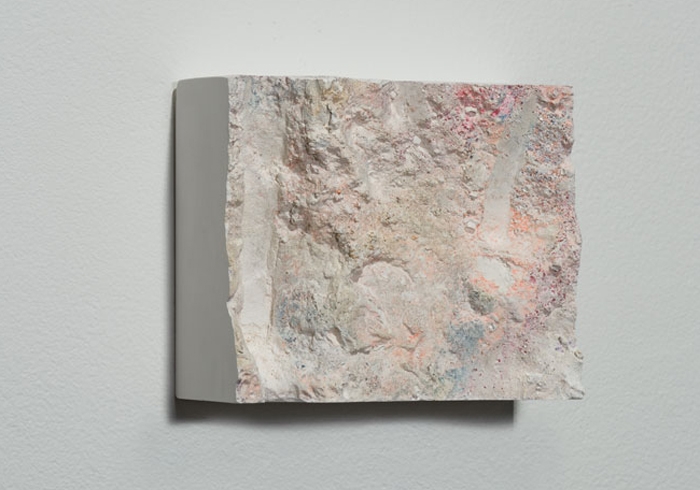LAXART, Los Angeles, 30 July – 2 September
Where lies the distinction between the words ‘touch’ and ‘hit’? If you’re thinking that the difference is a question of impact, doesn’t it depend on the materials involved? Touching a butterfly’s wing with your finger is more damaging than hitting an elephant’s hide with your hand, for example. Are tactility and physical harm just two ends of a sliding sensorial scale?
It’s an unsavoury thought, and I’m not entirely sure where it leads us, but it’s one that occurred to me in Zarouhie Abdalian’s exhibition, thanks to her juxtaposition of steel tool-heads against delicate Hydrocal casts taken from the surface of a chalk mine. The former – seven tarnished brown metal objects balanced on crisp white plinths – are titled brunt (i–vii), while the latter, from Chalk Mine Hollow (i–xii), consists of a series of small rectangular slabs mounted flush to the walls (all works 2017.) The tenderness of these fine impressions of the chalk contrasted with the evidence of chisel blows that once hacked away at it. The exhibition is so outwardly airy and genteel that it was a while before my thoughts became embroiled in parsing scales of imagined violence. This is an effect that Abdalian cultivates throughout her work.
Abdalian, who typically kindles reflections on broad socioeconomic, political and environmental issues through deft, smallscale sculptural interventions and soundworks, moves fluidly between the polarities of the micro and the macro. On a digital screen in a side room, black-and-white photographs show the craggy, lapidarian edge of a chisel, vastly magnified. Arranged in an adjacent space are steel and aluminium tools (pipes, beams, levers, bolts, etc) that have been bent out of shape and all usefulness by whatever colossal forces of nature they were once attempting to master.
Perhaps because of the recent visibility of mining as a political and environmental issue in the US news, perhaps because of Chalk Mine Hollow’s location in Mississippi and perhaps just because of the fraught times we’re living in, it seems appropriate to read these objects and images as signifiers of the brutal injustices of labour. A sound recording of stones knapping other stones made by Abdalian and Joseph Rosenzweig, titled threnody for the millions killed by silicosis (referring to the disease caused by inhalation of silica that led the Mississippi mine to be closed in 1912), appears to bear out this dynamic of victimhood.
Work might be read as an elegy on humankind’s assault on the natural world
In other circumstances, however, Work might primarily be read as an elegy on humankind’s assault on the natural world. The miners, perhaps, are actually the aggressors. More subtle is a third reading – one that I imagine Abdalian intends – that synthesises both of the above. When Homo sapiens first took rocks and reimagined them as tools, an unstoppable process was set in motion through which the Earth was reconstituted as a raw material for its own exploitation at the hands of humans. Millennia on, the process had continued until humankind cannibalistically was using members of its own species as expendable, readymade tools.
Abdalian’s exhibition is most compelling when it complicates power dynamics rather than allegorises them. Everywhere, nature is pushing back: rock imprints itself on the steel edge of the chisel; gravity contorts metal implements into softly withered, amputated nubs; mined chalk sickens and kills those who attack it. Both the darkly rusted hammerheads and the wrinkled, blotched surfaces of the Hydrocal slabs are evocative of skin – in this context, plainly (perhaps even simplistically) racialised. Abdalian refrains from sermonising, however, and we never find out what she really thinks about those beleaguered coal miners in Trumpland. On the contrary, labour is romanticised and – for better or for worse – abstracted. Work is as much about the Duchampian readymade (‘works which are not works of “art”’) as it is the backbreaking job of toiling underground. The gallery becomes a comfortable and calming haven from which to reflect on disquieting ideas both big and small, near and very far away. Jonathan Griffin
From the October 2017 issue of ArtReview
